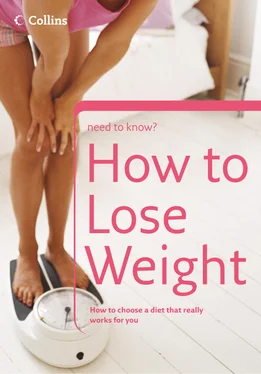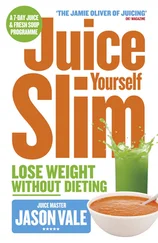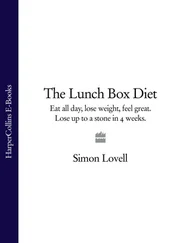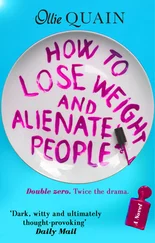must know
Calorie savings
Look over your food diary to identify the areas where it would be easy for you to make calorie savings.
Sample food diary for a single day
Breakfast
Med egg, 2 rashers back bacon, 1 tbsp vegetable oil, 2 slices white toast, 2 tsp butter, 200 ml glass orange juice, 2 cups tea, whole milk, 2 sugars
Lunch
100 g chicken, 15 cm baguette with 1 tbsp mayo, 25 g packet plain crisps, apple, 2 cups tea, whole milk, 2 sugars
Dinner
225 g grilled rump steak, 225 g jacket potato, 1 tbsp butter, 2 tbsp poached mushrooms, 1 grilled tomato, medium bowl strawberries, 2 tbsp double cream
Snacks/drinks
2 cups coffee, whole milk and 2 sugars; 2 chocolate digestives; 2 x 175 ml glasses red wine; 1 glass water
Total calories per day: 3,048
At this pre-weight loss stage your aim is just to observe everything you eat and drink over the diary period. You are not trying to lose weight – not yet anyway. The example shows the level of detail that is required.
Food diary rules
Write down everything you eat and drink, as you are eating it.
 Always be specific – include cooking methods, brand names, quantities (estimate as closely as you can) and varieties, e.g. ‘diet drink’ or ‘full-fat yogurt’.
Always be specific – include cooking methods, brand names, quantities (estimate as closely as you can) and varieties, e.g. ‘diet drink’ or ‘full-fat yogurt’.
Include ‘hidden’ ingredients such as butter in sandwiches or sugar on cereal.
Identifying calorie savings
After a few days of diary keeping it may well be that eating patterns can be seen more clearly, so that it is possible to see ways of reducing your calorie intake by swapping to lower-calorie, lower-fat foods or by reducing portion sizes. For example, from the diary it can be seen that the day’s intake is high in sugar and in full-fat products, such as butter, milk and oil. The table below shows just how many calories could be saved by swapping to different varieties:
| Swap this.. |
For this. . . |
Calorie saving |
| 12 tsp white sugar |
12 tsp sweetener |
192 |
| 300 ml whole milk |
300 ml skimmed milk |
90 |
| 2 tbsp double cream |
2 tbsp light single cream |
96 |
| 1 tbsp vegetable oil |
10 sprays one-cal oil spray |
125 |
| 2 X 175 ml red wine |
1 X175 ml red wine |
120 |
Making the swaps shown above would save 623 calories in a single day –without having to make any noticeable changes to the diet. Some people will find that there are easy, daily calorie-savings they can make in their diet, whereas others may identify regular but not daily occasions –such as a weekly takeaway or a night out –where big calorie-savings can be made at a stroke. This is why it is important to keep the food diary for as long as it takes to establish a pattern.
must know
Average intake
At the end of the diary period, the average daily calorie intake can be worked out by adding up the daily totals and dividing by the number of days. To do this, it is worth investing in a comprehensive calorie-counting guide which has thousands of food products, including branded ones.
How quickly should you lose?
Now that you know how many calories you need to maintain your weight, and how many you are currently eating each day, you can decide how much of an energy deficit you will need to set up to lose weight steadily and safely. Cutting back on food drastically– such as by sticking to a rigid 1,000 calories a day diet when your BMR is 3,000 calories – would undoubtedly lead to rapid weight loss. But it is very unlikely that you would be able to sustain it in the long term, leading to a dispiriting ‘failure’ and, probably, an equally rapid weight gain once you started eating normally again.
Gradual weight loss is best
Health professionals recommend that a safe and steady weight loss is about 1–2 lb (0.45–0.9 kg) a week. Slimming at this rate ensures that you will be losing fat rather than lean tissue, such as muscle, and it should be fairly easy to achieve without drastic calorie-cutting measures, so that you can stick with your plan without it feeling like a ‘diet’. And, as a bonus, research shows that people who lose weight slowly are more likely to keep it off in the long run.
As it takes an energy deficit of around 3,500 calories to lose 1lb of fat, a daily saving of about 500 calories should be enough to lose 1 lb a week (7 x 500). Saving 1,000 calories a day (say, from 3,000 to 2,000) could result in a 2lb weekly loss, but this depends on current intake: women should not try to lose weight on less than around 1,500 calories a day, while for men the minimum is around 1,900 calories a day.
In the first few weeks of a weight loss plan it is possible to lose more than 1lb or 2lb a week. This is because glycogen (the short-term store of surplus energy) is stored in three times its weight of water, which accounts for a lot of the initial weight loss. This can be a very motivating start to a weight-loss campaign and it may continue for longer than a week or two, especially if you have a lot of weight to lose.
must know
Working out calorie needs
For a rough guide to your daily calorie needs, multiply your weight in pounds by 15 if you are moderately active: or 13 if you have a sedentary lifestyle. Using Jane as an example, this method would estimate her total calorie needs at 2,173 compared to 2,130 for the four-step calculation.
There is no need for any drastic calorie cutting – or boring meals – when losing weight; healthy food can be filling and delicious.
must know
Calories from alcohol
These are not stored in the body but are used immediately as energy. That sounds like good news but it’s not; this is because instead the body stores calories from other sources such as fat, which tend to accumulate in fat deposits in the abdomen, and may account for the observation that many heavy drinkers are ‘apple-shaped’.
Weight loss, balance and health
This chapter has looked at ‘calories in and calories out’, a concept which is essential to understand in order to create an energy deficit. However, it is not enough on its own to help the slimmer because it does not address the other key question: what you should eat in order to ensure that a weight loss plan is also healthy, balanced and enjoyable for you to follow.
After all, if your only aim was to lose weight by creating an energy deficit, then the diet could consist of anything at all, as long as it saved calories. However, when you are devising an effective and personalized slimming plan, it is vital to ensure that your daily diet is healthy and balanced; that hunger is kept at bay; and that enough favourite foods are included so that the plan feels comfortable and enjoyable and you don’t feel that you are missing out on meals. All of these aspects are covered in the next section.

Adding lemon to a gin and tonic doesn’t make it healthy! Alcoholic drinks provide ‘empty calories’ with little nutritional value.
Energy deficit
By calculating your BMRand your calorie intake you will build up a picture of whether your current energy balance is likely to help you maintain your weight or whether you are consistently taking in too many calories for your needs.
Читать дальше

 Always be specific – include cooking methods, brand names, quantities (estimate as closely as you can) and varieties, e.g. ‘diet drink’ or ‘full-fat yogurt’.
Always be specific – include cooking methods, brand names, quantities (estimate as closely as you can) and varieties, e.g. ‘diet drink’ or ‘full-fat yogurt’.











